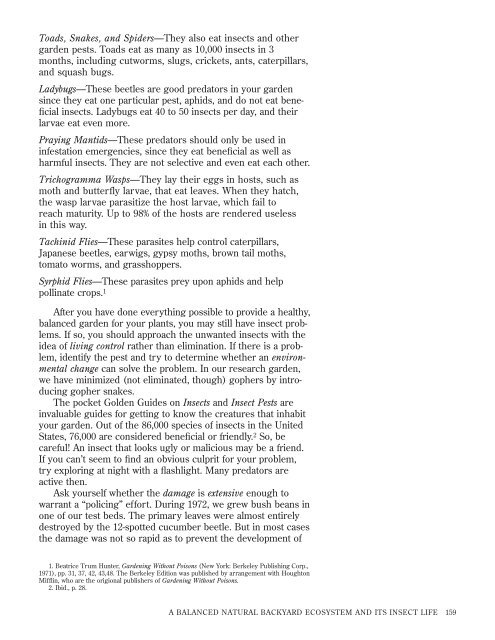How to Grow More Vegetables : And Fruits, Nuts ... - Shroomery
How to Grow More Vegetables : And Fruits, Nuts ... - Shroomery
How to Grow More Vegetables : And Fruits, Nuts ... - Shroomery
You also want an ePaper? Increase the reach of your titles
YUMPU automatically turns print PDFs into web optimized ePapers that Google loves.
Toads, Snakes, and Spiders—They also eat insects and other<br />
garden pests. Toads eat as many as 10,000 insects in 3<br />
months, including cutworms, slugs, crickets, ants, caterpillars,<br />
and squash bugs.<br />
Ladybugs—These beetles are good preda<strong>to</strong>rs in your garden<br />
since they eat one particular pest, aphids, and do not eat beneficial<br />
insects. Ladybugs eat 40 <strong>to</strong> 50 insects per day, and their<br />
larvae eat even more.<br />
Praying Mantids—These preda<strong>to</strong>rs should only be used in<br />
infestation emergencies, since they eat beneficial as well as<br />
harmful insects. They are not selective and even eat each other.<br />
Trichogramma Wasps—They lay their eggs in hosts, such as<br />
moth and butterfly larvae, that eat leaves. When they hatch,<br />
the wasp larvae parasitize the host larvae, which fail <strong>to</strong><br />
reach maturity. Up <strong>to</strong> 98% of the hosts are rendered useless<br />
in this way.<br />
Tachinid Flies—These parasites help control caterpillars,<br />
Japanese beetles, earwigs, gypsy moths, brown tail moths,<br />
<strong>to</strong>ma<strong>to</strong> worms, and grasshoppers.<br />
Syrphid Flies—These parasites prey upon aphids and help<br />
pollinate crops. 1<br />
After you have done everything possible <strong>to</strong> provide a healthy,<br />
balanced garden for your plants, you may still have insect problems.<br />
If so, you should approach the unwanted insects with the<br />
idea of living control rather than elimination. If there is a problem,<br />
identify the pest and try <strong>to</strong> determine whether an environmental<br />
change can solve the problem. In our research garden,<br />
we have minimized (not eliminated, though) gophers by introducing<br />
gopher snakes.<br />
The pocket Golden Guides on Insects and Insect Pests are<br />
invaluable guides for getting <strong>to</strong> know the creatures that inhabit<br />
your garden. Out of the 86,000 species of insects in the United<br />
States, 76,000 are considered beneficial or friendly. 2 So, be<br />
careful! An insect that looks ugly or malicious may be a friend.<br />
If you can’t seem <strong>to</strong> find an obvious culprit for your problem,<br />
try exploring at night with a flashlight. Many preda<strong>to</strong>rs are<br />
active then.<br />
Ask yourself whether the damage is extensive enough <strong>to</strong><br />
warrant a “policing” effort. During 1972, we grew bush beans in<br />
one of our test beds. The primary leaves were almost entirely<br />
destroyed by the 12-spotted cucumber beetle. But in most cases<br />
the damage was not so rapid as <strong>to</strong> prevent the development of<br />
1. Beatrice Trum Hunter, Gardening Without Poisons (New York: Berkeley Publishing Corp.,<br />
1971), pp. 31, 37, 42, 43,48. The Berkeley Edition was published by arrangement with Hough<strong>to</strong>n<br />
Mifflin, who are the origional publishers of Gardening Without Poisons.<br />
2. Ibid., p. 28.<br />
A BALANCED NATURAL BACKYARD ECOSYSTEM AND ITS INSECT LIFE 159












